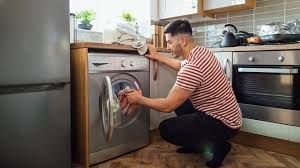How to Repair a Leaky Washing Machine?
A leaky washing machine can be a frustrating issue to deal with, especially when you find water pooling around your laundry area. Fortunately, many washing machine leaks are fixable with some basic troubleshooting and repair skills. This article will guide you through common causes of leaks, how to diagnose them, and step-by-step instructions for fixing the most frequent problems.
Safety First
Before starting any repair, make sure to prioritize safety:
- Unplug the washing machine: Disconnect it from the power supply to avoid the risk of electrical shock.
- Turn off the water supply: Locate the shut-off valves (usually behind the washing machine) and turn them off to prevent water flow while you work.
Common Causes of Washing Machine Leaks
Washing machines can leak for various reasons. The leak's location, frequency, and conditions can give clues about what’s wrong. Here are some of the most common causes:
1. Faulty Hoses
The water inlet hoses (connected at the back of the machine) or the drain hose can crack, become loose, or be improperly installed, leading to leaks.
2. Door Seal (Front-Load Washers)
In front-load washing machines, the rubber door gasket or seal can accumulate dirt or develop tears, which compromises its watertight integrity.
3. Clogged or Damaged Drain Pump
A washing machine’s drain pump is responsible for expelling water during the spin cycle. Blockages or damage to the pump or its connections can result in leaks.
4. Defective Water Inlet Valve
The inlet valve controls water flow into the washing machine. A malfunctioning or damaged inlet valve can cause leaks at the back of the machine.
5. Tub-to-Pump Hose
This internal hose connects the washing machine’s tub to the pump. A tear, clog, or loose connection can result in a leak, usually noticed near the machine's bottom.
6. Overloading or Improper Use
Overloading the washing machine or using too much detergent can cause excessive vibration and water spilling over the drum. This can sometimes be mistaken for a leak.
Step-by-Step Repair Guide
1. Check the Water Hoses
- Symptoms: Water pooling behind the washing machine, especially when it's filling or draining.
- Tools Needed: Adjustable wrench, pliers, bucket, towels.
Step 1: Pull the washing machine away from the wall to access the hoses at the back.
Step 2: Inspect the hoses for cracks, kinks, or wear. Also, check the connections at both the machine and the wall to ensure they’re tightly secured.
Step 3: If a hose is damaged, replace it with a new one. To replace, turn off the water supply, unscrew the old hose using pliers or an adjustable wrench, and attach a new hose. Ensure it is snug and properly tightened to prevent leaks.
Step 4: For drain hoses, make sure they are properly inserted into the standpipe or laundry tub. An improperly positioned drain hose can cause water to spill out during the draining process.
Step 5: Turn the water supply back on and run a short cycle to check for leaks.
2. Inspect the Door Seal (Front-Load Washers)
- Symptoms: Water leaking from the front of a front-load washer, usually during or after a wash cycle.
- Tools Needed: Mild detergent, soft cloth, flashlight.
Step 1: Open the washer door and examine the rubber seal (gasket). Look for visible tears, holes, or a buildup of dirt and detergent residue.
Step 2: Clean the gasket using a soft cloth and a mild detergent to remove any debris or mold, which can compromise the seal.
Step 3: If the gasket has visible damage, it will need to be replaced. To replace it, consult the user manual for your specific washing machine model. Most gasket replacements involve removing the door and retaining clips that hold the seal in place.
Step 4: After replacement or cleaning, run an empty cycle to check if the leak persists.
3. Clear or Replace the Drain Pump
- Symptoms: Leaks occurring during the draining cycle or water collecting underneath the washing machine.
- Tools Needed: Towels, bucket, pliers, screwdriver.
Step 1: Locate the drain pump. It’s usually accessible by removing the front panel of the washer. For top-load washers, you may need to tilt the washer back or remove the back panel.
Step 2: Place towels and a bucket under the pump to catch any water spills.
Step 3: Inspect the pump for blockages. If you see debris inside the pump or its connections, use pliers to remove it.
Step 4: Check for cracks or damage to the pump housing. If the pump is damaged, you will need to replace it. Unscrew the pump from its mount, detach the hose connections, and install the new pump by reversing these steps.
Step 5: Reassemble the washing machine panels and run a short cycle to ensure there are no leaks.
4. Test the Water Inlet Valve
- Symptoms: Leaks from the back of the washing machine, especially when it’s filling with water.
- Tools Needed: Screwdriver, multimeter (optional).
Step 1: Unplug the washing machine and turn off the water supply.
Step 2: Remove the back panel to access the water inlet valve, usually found where the hoses connect to the machine.
Step 3: Inspect the valve for visible damage, corrosion, or debris. Also, check the hoses connected to the valve.
Step 4: If you suspect the valve is faulty, you can test it with a multimeter. If the readings indicate a problem, replace the valve by disconnecting the electrical connectors and unscrewing it from the washing machine frame.
Step 5: Reattach the new inlet valve, reconnect the hoses, and test the washing machine for leaks.
5. Check the Tub-to-Pump Hose
- Symptoms: Water leaking from the bottom of the washing machine.
- Tools Needed: Pliers, screwdriver, towels.
Step 1: Unplug the washer and tilt it back or remove the front panel to access the internal hoses.
Step 2: Locate the tub-to-pump hose (a thick rubber hose). Inspect it for cracks, holes, or loose clamps.
Step 3: If damaged, detach the hose using pliers to loosen the clamps and replace it with a new one.
Step 4: Tighten the clamps securely around the new hose to prevent leaks.
Step 5: Run a test cycle to ensure the issue is resolved.
6. Avoid Overloading and Excess Detergent
- Symptoms: Water splashing out of the drum, especially during the spin cycle.
- Solution: Always adhere to the washer’s load capacity. Overloading can cause excess vibration, leading to leaks. Additionally, using too much detergent can cause excessive suds, which may overflow.
When to Call a Professional
While many leaks can be fixed with DIY methods, some situations may require professional help:
- Persistent leaks: If the leak continues despite trying the above fixes, it may indicate a more complex issue, such as a cracked drum or internal component failure.
- Electrical or control issues: If the washing machine has electrical problems, such as faulty wiring, it's safer to consult a technician.
- Under warranty: If your washing machine is still under warranty, contact the manufacturer or authorized service provider to avoid voiding the warranty.
Preventive Maintenance Tips
To avoid leaks in the future, consider these preventive measures:
- Inspect hoses regularly: Check water inlet and drain hoses every few months for signs of wear and replace them every 5 years, even if they look fine.
- Clean the door seal: Wipe the door seal of front-load washers regularly to prevent mold and residue buildup.
- Use the right detergent: Only use high-efficiency (HE) detergent in HE washers, and avoid overusing detergent in general.
Fix a Leaky Washing Machine
Repairing a leaky washing machine can often be a straightforward process with the right tools and knowledge. By following the steps outlined in this guide, you can diagnose and fix most leaks, saving you time and money on professional repairs. However, if you encounter complex issues or feel uncomfortable with the repair, don't hesitate to call in a professional technician. Proper maintenance and timely repairs will ensure your washing machine operates efficiently and leak-free for years to come.




